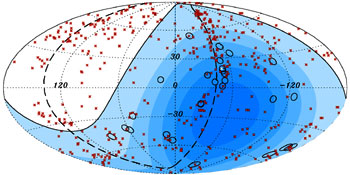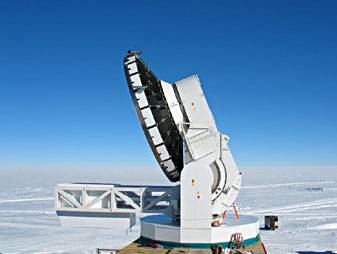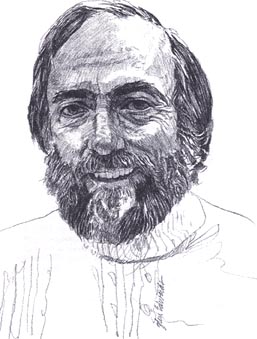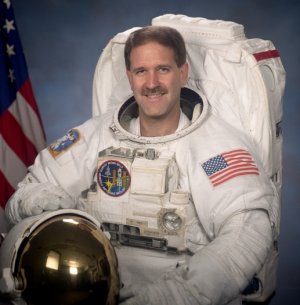 |
 |
 |
 |
 |
 |
 |
 |
 |
 |
|
KICP Workshops & Events
|
KICP Lectures, Talks, & Events, 2009 Clem Pryke, "Viewing the Beginning of the Universe from the Bottom of the World" January 17, 2009 | 10:00 AM | Adler Planetarium, 1300 South Lake Shore Drive, Chicago, IL Website The South Pole is otherworldly. Join University of Chicago Professor Clem Pryke, PhD and learn about his research expeditions to Antarctica and why scientists travel to the end of the earth to learn about space. You’ll hear what it is like to work at the Amundsen-Scott South Pole Station where summer temperatures often hover at 40 degrees below zero, try on Extreme Cold Weather gear, and learn about the exciting questions about the universe that are being answered by astronomers at the ends of the earth. This special event is a joint partnership between the Kavli institute for Cosmological Physics at the University of Chicago and The Adler Planetarium. Read more >> Related Links: KICP Members: Clement L. Pryke Hsiao-Wen Chen and Michael Gladders, "Big Questions Big Glass Tour" January 17, 2009 | 1:00 PM | Adler Planetarium, 1300 South Lake Shore Drive, Chicago, IL Website Join University of Chicago astronomers Dr. Hsiao-Wen Chen and Dr. Mike Gladders on a guided tour of some of the biggest unanswered questions in astrophysics today. Explore the world's largest telescopes (the "big glass") and the mysteries they are being used to explore (e.g. the nature of dark matter, dark energy, and the nature of the universe itself). See how gamma-ray bursts, explosive fireballs, which foreshadow the birth of black holes at edge of the known universe, are being used to probe the local universe. See how massive clusters of galaxies thousands of times larger than our own Milky Way can gravitationally magnify our view of the distant universe. With the mapmakers as your guides, examine cosmic maps and learn what they reveal about the earliest moments of the universe. We will visit the remotest reaches of our universe and all places in between - including the observatories where we conduct our research and their telescopes, the miracle machines, which can unlock fundamental mysteries of our universe. This special event is a joint partnership between the Kavli institute for Cosmological Physics at the University of Chicago and The Adler Planetarium. Read more >> Related Links: KICP Members: Hsiao-Wen Chen; Michael D. Gladders John Carlstrom, "The Cosmic Microwave Background: Progress and Prospects" February 16, 2009 | 9:30 AM | Hyatt Regency, Chicago Website 2009 Annual Meeting of the American Association for the Advancement of Science. John Carlstrom, "The Cosmic Microwave Background: Progress and Prospects" Abstract: I will review recent results associated with measurements of the Cosmic Microwave Background Radiation, our most sensitive direct probe of the early universe. in Session "Origins and Endings: From the Beginning to the End of the Universe" (Moderator--Angela Olinto, University of Chicago, Chicago, IL) --- Over the past decade, our view of both the possible origin and the ultimate fate of the universe have dramatically changed. This session will review how cutting-edge current research is shedding light on both of these cosmic questions and in fact how they may be related. In so doing, they are giving us a new sense of our planet's place in the universe. Subjects will include cosmic microwave background probes, gravity waves, dark matter, dark energy, the anthropic principle, and multiverses. Read more >> Related Links: KICP Members: John E. Carlstrom Scott Dodelson, "Gravitational Waves as a Probe of the Early Universe" February 16, 2009 | 9:30 AM | Hyatt Regency, Chicago Website 2009 Annual Meeting of the American Association for the Advancement of Science. Scott Dodelson, "Gravitational Waves as a Probe of the Early Universe" Abstract: The theory of inflation posits that small quantum mechanical fluctuations generated in the early universe seeded the majestic structure observed today. This theory of our origins has passed several observational hurdles over the past decade. The definitive confirmation, though, will come when astronomers detect gravity waves generated during inflation. The race is on to find these primordial ripples in the fabric of space-time. Understanding this ultimate of all origins appears to be within our grasp. in Session "Origins and Endings: From the Beginning to the End of the Universe" (Moderator--Angela Olinto, University of Chicago, Chicago, IL) --- Over the past decade, our view of both the possible origin and the ultimate fate of the universe have dramatically changed. This session will review how cutting-edge current research is shedding light on both of these cosmic questions and in fact how they may be related. In so doing, they are giving us a new sense of our planet's place in the universe. Subjects will include cosmic microwave background probes, gravity waves, dark matter, dark energy, the anthropic principle, and multiverses. Read more >> Related Links: KICP Members: Scott Dodelson Michael Turner, Rocky Kolb, and Joe Lykken: "The Dark Side of the Universe: Dark Matter and Dark Energy" February 24, 2009 | 5:30 PM | Blackstone Hotel: 636 South Michigan Ave Chicago, IL Cosmologists are making ever more precise measurements of the Universe and have found that they know almost precisely nothing about what it is made of. Only one percent of the Universe is made of the kind of everyday matter that can be seen with telescopes--the stars, the planets, us. Another 3.5 percent is made of hot gas that can only be seen with X-ray instruments. The rest is a complete mystery: 24 percent is dark matter whose gravity holds our galaxy together, and the remaining 71 percent is dark energy, whose repulsive gravity is causing the expansion of the Universe to speed up, not slow down as expected. Three prominent scientists--astronomer Rocky Kolb, particle physicist Joe Lykken, and cosmologist Michael Turner--discuss what we know about the nature of dark matter and dark energy. They discuss the roles of particle accelerators and telescopes in solving the mystery of the unseen 96 percent the Universe. They conclude by explaining what all, this means for our understanding of the elementary particles and the fate of the Universe. Related Links: KICP Members: Edward W. Kolb; Michael S. Turner Cafe Scientifique: Angela Olinto, "Chasing Cosmic Bullets" March 9, 2009 | 7:00 PM | Map Room, 1949 North Hoyne Ave Chicago, IL  Background urls: - Auger Observatory - Detecting Cosmic Rays: The Auger Observatory and Frontier Science Related Links: KICP Members: Angela V. Olinto Scientific projects: Pierre Auger Observatory (AUGER) KICP @ 2009 NSTA National Conference on Science Education "Celebrating the Year of Science" March 19 - 22, 2009 | New Orleans, LA Website 2009 NSTA National Conference in New Orleans From brains to the Big Bang, take a crash course in forefront science with the NSF Physics Frontier Centers including hands-on activities and summer opportunities. Physics Frontier Centers (PFCs) are literally supposed to rewrite the laws of physics. These interdisciplinary research centers span a broad range of superlative science: the coldest, fastest, hottest, biggest; and span the globe (e.g., South Pole). Join us for some science headline news, a series of demos and activities grounded in the classroom but based on the latest in cosmology, biophysics, plasma physics (e.g., a fortune cookie collider and virtual cells); and a smorgasbord of opportunities for you and your students: distance learning (including alternative media such as YouTube and podcasts), research internships, outreach programs, visiting science shows, and field tested activities that integrate science on the edge. Read more >> Related Links: KICP Members: Randall H. Landsberg KICP Students: Robert Friedman KICP open house for prospective graduate students April 3, 2009 | 1:00 PM | LASR conference room This Friday, April 3, is the physics department prospective graduate student open house. Students interested in astrophysics will join us for the KICP lunch talk shortly after 12:00 noon. After the talk, the prospective students will be available to meet KICP members in the LASR conference room. Please join us in for a discussion of KICP activities and research opportunities at 1PM in the LASR lounge. After the discussions the students will have time to meet with people individually. South Pole Telescope in 'Around the World in 80 Telescopes' webcast April 4, 2009 | 2:25 AM | South Pole, Antarctica  Find out what's happening at a research observatory in your country, or on the other side of the planet, and discover what astronomers are doing right now! Who is observing? What are they researching? What do they hope to discover? You'll see a snapshot of life at many different observatories where astronomers will present exclusive images and talk about their work. Some will be observing distant galaxies, searching for extrasolar planets around other stars or studying our own Solar System. Some will be studying the Universe in visible light, others in radio waves or other wavelengths. Some may be working at solar observatories or with telescopes out in space. All of them will have a different story to tell. Related Links: KICP Members: John E. Carlstrom Scientific projects: South Pole Telescope (SPT) Cafe Scientifique: Evalyn Gates, "Looking for Dark Matter through the Bottom of a Wine Glass" April 22, 2009 | 7:00 PM | Hopleaf, 5148 N. Clark  What is the Universe made of? New data insist that normal matter - everything you were ever taught in chemistry class - makes up only about 5% of the total amount of matter and energy in the Universe. Dark Matter, an exotic new form of matter that has never been directly detected, accounts for about 23%, while the remaining 72% is not matter of any kind, but some strange new substance, dubbed Dark Energy, that is fueling an accelerated expansion of space itself. The search for dark matter and dark energy is complicated by the fact that they cannot be seen directly with even our most powerful telescopes. Instead, cosmologists are using the warps and dimples in space-time described by Einstein in his theory of General Relativity as giant "cosmic lenses". Gravitational lensing - also known as Einstein's Telescope - allows us to probe the dark Universe in an entirely new way: to search for black holes and planets within our own Galaxy, map out the dark matter that dominates a galaxy or cluster of galaxies, and detect the imprint of dark energy on the web of dark matter that winds across the cosmos. Related Links: KICP Members: Evalyn I. Gates 70th Compton Lectures: Eric Switzer, "The physics of energy devices" October 3 - December 12, 2009 | 11:00 AM | Kersten Physics Teaching Center 5720 S. Ellis Avenue, Room 106 Chicago, IL 60637 Right now, nuclei are splitting, carbon atoms are rejoining oxygen atoms, generators are turning, transformers are stepping voltages up and down, oil pumpjacks are nodding, refiners are processing, and cars are whirring on numerous highways. Our modern life depends on a bewildering number and variety of transformations of energy. These all act together transparently to provide our everyday conveniences and essentials, and are easy to take for granted. The energy transformations employ many key ideas of physics that have been developed in the last century and a half. Indeed, the emergence of almost every major area of physics went hand-in-hand with the invention of practical devices that define our modern life. The lectures will break several of these technologies down to their essential phenomena, and put those phenomena in the context of the development of physics as a field. Eric Switzer will review some of the essential physics of energy technologies in an approximately chronological order, from outcomes of electrodynamics and thermodynamics to applications of more modern nuclear and condensed matter physics. Related Links: KICP Members: Eric Switzer Cafe Scientifique: Kip Thorne, "The Warped Side of the Universe" October 19, 2009 | 7:00 PM | Map Room, 1949 North Hoyne Ave Chicago, IL  Our Universe has a "warped side": objects and phenomena that are made not from matter, but rather from warped space and warped time. Examples include black holes, and the big-bang singularity from which the Universe was born. Thorne will discuss this mysterious warped side, the quest to simulate it using supercomputers, and the quest to observe it using gravitational waves and strange telescopes. Kip Thorne's website Related Links: KICP Members: Randall H. Landsberg Hubble's Story with NASA Astronaut John Grunsfeld October 28, 2009 | 6:00 PM | SAIC Ballroom, 112 South Michigan Ave. Website Basketball in Space In May during the Hubble Space Telescope (HST) servicing mission, John Grunsfeld, SM'84 PhD'88, paid homage to fellow UC alumnus Edwin Hubble, after whom the telescope was named. Hubble, an astronomer whose seminal contributions to the field greatly expanded our understanding of the Universe, also played forward on the Maroons' Big Ten champion basketball teams of 1907-08 and 1908-09. Hubble's Story In May of 2009, the Hubble Space Telescope's last service mission successfully upgraded and repaired the telescope to include new cameras and instruments. During the 12 day mission in orbit, the Hubble Servicing Mission 4 (STS-125) performed 5 spacewalks to complete the upgrades so that the telescope could begin a new journey of discovery. Join us for a discussion with Astronaut John Grunsfeld who will describe the adventures of working in orbit on the Hubble Space Telescope and the exciting scientific results that the new instruments provide. Read more >> Related Links: KICP Members: Edward W. Kolb Michael Turner, The Dark Side of the Universe: Beyond stars and the starstuff we are made of" November 10, 2009 | 7:30 PM | Dudley Observatory, NY Website The sky is filled with hundreds of billions of galaxies, all lit up by their stars. But, stars account for less than one percent of the material in the Universe, and galaxies are held together by a new form of matter -- dark matter -- that accounts for 1/3 of the stuff in the Universe. The other 2/3 exists as in an even more mysterious form -- dark energy -- and is causing the expansion of the Universe to speed up, rather than slow down. Michael Turner's research focuses on the application of modern ideas in elementary particle theory to cosmology and astrophysics. He is a member of the National Academy of Sciences and a leading proponent of the theory of the origin of the universe known as the "Cold Dark Matter Theory." Turner chaired the National Research Council's Committee on the Physics of the Universe, which in 2003 published Connecting Quarks with the Cosmos. The report assessed the scientific opportunities that occur on the frontiers of research at the intersection of physics and astronomy. Turner completed a two-year term as assistant director for mathematical and physical sciences at the National Science Foundation in 2006. Read more >> Related Links: KICP Members: Michael S. Turner |







 Overview
Overview